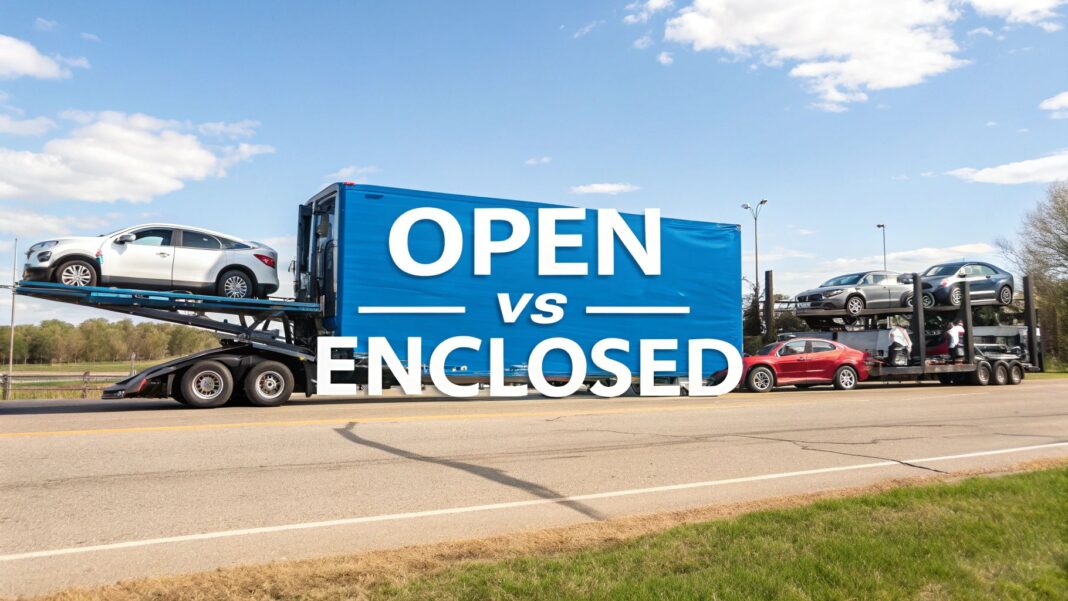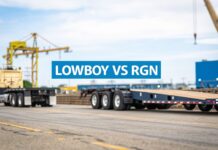
When you need to ship your car, the first critical decision you'll make is choosing between an open or enclosed carrier. This choice directly impacts the cost, level of protection, and even the scheduling of your vehicle's transport. This guide provides actionable insights to help you select the right service for your specific needs.
It’s not about which option is better overall; it’s about making the most strategic choice for your vehicle and your circumstances.
Open vs. Enclosed Transport: A Head-to-Head Comparison
At its core, the choice between open vs. enclosed auto transport is a trade-off between cost-effectiveness and comprehensive protection. For a standard vehicle, open transport is the practical, budget-friendly solution. For a classic, luxury, or high-value car, the superior protection of an enclosed carrier is a necessary investment.
Open Auto Transport: The Industry Standard
Open auto transport is the most common and economical method for shipping standard vehicles like sedans, SUVs, and daily-driver trucks. These are the double-decker carriers frequently seen on highways.
Because these trucks can transport up to 10 cars simultaneously, carriers can offer lower prices due to economies of scale. This method is efficient, widely available, and is the go-to for the vast majority of vehicle shipments.
Enclosed Auto Transport: White-Glove Protection
If you're shipping a classic, exotic, luxury, or customized vehicle, the higher cost of enclosed transport provides essential peace of mind. Your car is transported inside a fully sealed trailer, shielding it from weather, road debris like rocks and dust, and potential theft.
This is the premium service of auto transport, ensuring your valuable vehicle arrives in the same condition it departed.
This visual highlights the core trade-off. While open transport is the industry workhorse due to its cost-efficiency, enclosed transport serves a critical role for vehicles requiring the highest standard of care.
Actionable Insight: The decision hinges on your vehicle's value and your risk tolerance. Standard cars are well-suited for open carriers, while high-value vehicles warrant the security of an enclosed trailer to protect their investment.
Open vs. Enclosed Transport At A Glance
This table provides a direct comparison of the key features to help you make a quick, informed decision based on your priorities.
| Feature | Open Auto Transport | Enclosed Auto Transport |
|---|---|---|
| Cost | More affordable, budget-friendly | Higher cost, typically 40-60% more |
| Protection Level | Exposed to weather & road debris | Fully protected from all external elements |
| Availability | High availability, faster scheduling | Less common, may require more lead time |
| Best For | Daily drivers, standard cars, SUVs | Classic, luxury, exotic, high-value cars |
| Carrier Capacity | Typically 8-10 vehicles per carrier | Typically 1-6 vehicles per carrier |
Ultimately, this table simplifies your choice. Prioritizing cost and scheduling speed points to open transport. Prioritizing absolute protection points to enclosed.
Understanding Open Auto Transport: The Industry Standard
If you’ve ever seen a massive, two-level truck hauling a fleet of cars down the highway, you’ve seen open auto transport. This is the workhorse of the vehicle shipping world, and for good reason—it’s responsible for the overwhelming majority of car shipments across the country. Its popularity isn't by chance; it’s a direct result of being incredibly efficient and budget-friendly.
Open carriers are built to maximize their load, typically fitting 8 to 10 vehicles on a single trailer. By moving so many cars at once, the carrier achieves a huge economy of scale. The costs for fuel, the driver's time, and truck maintenance get spread across all the vehicles, which is why this method is always the more affordable option compared to enclosed shipping.

Why Is It The Go-To Choice for Most People?
For anyone shipping a standard car—be it a sedan, SUV, or your daily commuter—open transport hits the sweet spot between cost and reliability. These vehicles are designed for the open road and are built to withstand sun, rain, and road dust. Shipping on an open carrier exposes them to the same elements they encounter daily.
The primary concern for most customers is road debris. While a minimal risk exists, it's statistically low and comparable to the exposure your car gets during a long highway drive. Professional drivers use secure tie-downs and strategic loading techniques to lock every vehicle in place and mitigate potential issues.
A Realistic Perspective: The likelihood of significant damage from road debris on an open carrier is minimal. For a standard vehicle, the substantial cost savings almost always outweigh the slight risk of a minor cosmetic imperfection.
This practicality is why open auto transport is dominant, accounting for nearly 49.7% of the auto transport market as of 2023. It provides the most logical and cost-effective solution for everyday vehicles.
Practical Advantages That Go Beyond Price
The benefits aren't just about saving money. Open transport offers some serious logistical perks that can make your shipping experience much smoother. Because it's the industry standard, there are simply way more open carriers on the road than enclosed ones.
This high availability translates into direct benefits for you:
- Faster Pickups: More trucks on the road increase the likelihood of finding a carrier near you, which often leads to quicker pickup times.
- Scheduling Flexibility: A vast network of drivers and routes provides more options to align with your moving schedule.
- Easier to Book: The high volume of open carriers means you are less likely to encounter long booking waits, even during peak seasons.
This operational agility is a huge part of its appeal. If you need your car picked up promptly, open transport is usually the most efficient choice. For a more detailed look, our article on open trailer auto transport breaks it down even further.
At the end of the day, open transport is all about efficiency. It’s a reliable and secure way to move a standard vehicle without overspending. If you need a practical, no-frills solution that gets the job done, this is it.
Exploring Enclosed Auto Transport For Premium Protection
When your car is more than just a daily driver, the conversation shifts from simple transport to premium protection. This is where enclosed auto transport comes in. Think of it as a white-glove service designed for vehicles that require an uncompromising level of care during shipping. It’s the go-to choice for owners of classic cars, luxury vehicles, and high-value investments.
Unlike standard open carriers, enclosed trailers create a fully sealed, protective bubble around your vehicle. This means total isolation from rain, snow, hail, and damaging UV rays. Just as importantly, it forms a solid barrier against road debris—the rocks, gravel, and dirt that cause those frustrating paint chips and scratches. The peace of mind that comes with this level of security is really what you're paying for.

Differentiating Enclosed Carrier Types
It's important to know that not all enclosed carriers are built the same. You'll generally run into two main types: hard-sided and soft-sided trailers. Each offers a different level of protection and fits different needs.
-
Hard-Sided Enclosed Carriers: This is the top tier of vehicle protection. With solid metal walls and a roof, these trailers are essentially mobile garages. They offer the absolute best defense against weather, road hazards, and even potential theft. Many are also equipped with climate control and specialized loading gear.
-
Soft-Sided Enclosed Carriers: These trailers use a sturdy frame covered with heavy-duty canvas or vinyl. They still provide great protection from most weather and flying debris, but they lack the rigid security of a hard-sided trailer. This option often serves as a good middle ground and can be slightly more affordable.
Ultimately, your choice between the two will probably come down to the value of your vehicle and your personal comfort level with risk.
When Enclosed Transport Is A Necessity
For some vehicles, the extra cost of enclosed shipping isn't a luxury—it's a smart investment. This service is specifically designed for situations where even a minor scratch could have a major impact on a car's value or integrity.
Here are a few scenarios where it just makes sense:
- Classic and Antique Cars: Original paint and flawless condition are integral to a vintage car's value. Enclosed shipping is the only way to preserve that integrity during transit.
- Exotic and Luxury Models: For high-end vehicles like a Ferrari, Lamborghini, or Rolls-Royce, discreet and secure transport prevents damage and discourages unwanted attention.
- Race Cars and Low-Clearance Vehicles: Standard ramps can damage vehicles with low ground clearance. Many enclosed carriers feature hydraulic lift gates that load the car horizontally, preventing costly damage to the undercarriage.
- Newly Purchased or Collector Vehicles: When you've just made a significant investment in a new luxury car or a rare collector's piece, enclosed transport ensures it arrives in pristine, showroom-ready condition.
Think of it this way: the higher upfront cost of enclosed transport is really an insurance policy. It's there to protect the much larger investment you have in the vehicle itself.
This focus on meticulous care is why the market is growing. In fact, the enclosed auto transport sector is expected to hit around $6.14 billion by 2025, largely driven by owners of high-end and classic cars who demand better protection. If you're weighing your options, digging into specialized enclosed vehicle transport services can give you a clearer picture of the premium features available.
A Detailed Cost Analysis Of Vehicle Shipping
https://www.youtube.com/embed/yGqGDEIM3t4
Figuring out the cost of shipping a car isn't as simple as picking a service. While everyone knows enclosed shipping is the premium option, the final price on your quote is a blend of several different factors. The "open vs. enclosed auto transport" choice is a big one, but it's just the first piece of the puzzle.
To get a true feel for what you'll pay, you have to look at the entire journey. Distance is the most obvious part, of course, but other, more subtle variables can swing the price just as much.
Key Variables That Drive Your Shipping Quote
Think of your shipping quote as a custom price tag built just for your situation. Here are the main elements that go into building it.
-
Vehicle Size and Weight: A large pickup truck or SUV occupies more space and consumes a larger portion of the carrier's weight limit than a compact sedan, resulting in a higher cost.
-
Route Popularity: Transporting a vehicle between major metropolitan areas like Los Angeles and New York is typically more affordable due to high carrier traffic and competition. Conversely, pickup or delivery in a remote, rural location will cost more to compensate the driver for detouring from primary shipping lanes.
-
Seasonality: The auto transport industry experiences peak seasons. Demand is highest from late spring through summer, often leading to increased prices. Winter shipping, particularly in northern states, can also be more expensive due to hazardous road conditions and fewer available drivers.
-
Carrier Availability: Ultimately, pricing is governed by supply and demand. During peak times or on less common routes, you are competing for limited space on a truck, which drives up the cost for both open and enclosed services.
Comparing Estimated Shipping Costs
To provide a concrete understanding of the cost differences, this table outlines ballpark figures for various scenarios. It illustrates how costs for open and enclosed carriers compare across different vehicle types and distances.
Estimated Shipping Cost Comparison By Vehicle Type And Distance
| Vehicle Type | Distance | Estimated Open Carrier Cost | Estimated Enclosed Carrier Cost |
|---|---|---|---|
| Standard Sedan | 500 Miles | $450 – $600 | $700 – $950 |
| Standard Sedan | 2,500 Miles | $1,100 – $1,400 | $1,700 – $2,200 |
| Mid-Size SUV | 500 Miles | $550 – $750 | $850 – $1,100 |
| Mid-Size SUV | 2,500 Miles | $1,300 – $1,600 | $1,900 – $2,500 |
| Classic Convertible | 1,500 Miles | $900 – $1,200 | $1,400 – $1,850 |
The price for enclosed transport is consistently higher, typically ranging from 40-60% more than open transport. For a precise quote based on your specific vehicle and route, you can get more details on how to calculate the cost to ship a car here.
Actionable Tip: Before you book anything, always ask to see the carrier's certificate of insurance. Make sure their coverage is high enough to cover the full value of your vehicle—this is non-negotiable if you're shipping a classic, exotic, or luxury car.
Understanding what commercial vehicle insurance entails is key, as it's a major operational cost for any legitimate transport company. A trustworthy shipper won't hesitate to share their insurance documents with you, giving you the confidence that your car is in good hands.
How To Choose The Right Transport For Your Situation

When it comes to shipping your car, there’s no single "best" answer. The right choice between open and enclosed transport really boils down to your specific car and your situation. To get past a simple pros-and-cons list, you need to think practically about your car's value, your budget, and frankly, your own tolerance for risk.
Let's walk through a few common scenarios. Seeing how these factors play out in the real world will help you make a logical decision you can feel good about.
Scenario 1: The Reliable Daily Driver
Imagine you're moving for a new job and need to get your trusty 10-year-old sedan to your new home. It’s a great car, but it’s already collected a few dings and scratches from years of commuting and parking lots.
In a case like this, the decision is pretty straightforward. Your main goals are almost certainly affordability and convenience. Open transport is the workhorse of the industry for good reason—it’s economical and widely available, which often means you can find a spot on a truck much faster. The small risk of a rock chip is really no different from what the car faces on any long road trip.
- Vehicle Value: Standard, with normal wear and tear.
- Budget: Cost is a major factor.
- Risk Tolerance: Moderate. Another small scratch wouldn't be a disaster.
Recommendation: Open transport is the clear winner here. The money you save easily outweighs the tiny risk of minor cosmetic damage to a standard vehicle.
Scenario 2: The Vintage Muscle Car Acquisition
Now, let’s flip the script. You just bought a beautifully restored 1969 muscle car at auction. The paint job is flawless, and it represents a serious financial investment. The only goal is getting it home in the exact pristine condition it’s in right now.
Here, the priorities are completely different. Protection is everything, and the budget becomes secondary to preserving the car’s value. The thought of road salt, hail, or a stray rock marring that perfect finish is unthinkable.
As a rule of thumb, if your vehicle's value is north of $75,000, or it holds irreplaceable sentimental value, enclosed transport isn't a luxury—it's a smart investment.
An enclosed trailer offers a fully sealed environment, shielding your car from all weather and road hazards. It also provides a higher degree of security and privacy during the journey, which is a big deal for a high-value, eye-catching vehicle.
Recommendation: This one’s a no-brainer. Enclosed transport is the only way to go. The extra cost is a small price to pay for total peace of mind.
Scenario 3: The Low-Clearance Sports Car
What if you're shipping a modern sports car with a low profile? It might not be a priceless classic, but its low ground clearance creates a very specific problem. The standard ramps on many open carriers are too steep, which can easily scrape and damage the front lip or undercarriage.
In this situation, the deciding factor isn't just about protecting the car from the elements, but about having the right equipment for safe loading.
Many enclosed carriers come equipped with hydraulic lift gates, which act like an elevator, lifting the car horizontally onto the truck. This is the gold standard for preventing damage to cars that sit close to the ground. While some open carriers have extra-long ramps, a lift gate is the safest bet.
- Vehicle Value: High, but modern.
- Primary Concern: Avoiding physical damage during loading and unloading.
- Key Feature Needed: Hydraulic lift gate.
Recommendation: Enclosed transport with a hydraulic lift gate is the way to go. It directly addresses the biggest risk for this type of car. This need for specialized handling is a big reason for the growth in enclosed transport, as demand for protecting everything from EVs to low-slung supercars has increased. You can read more about these global transport trends on gminsights.com.
Common Car Shipping Questions Answered
Even after weighing the pros and cons, you probably have a few practical questions still rattling around. Choosing between open vs enclosed auto transport is a big decision, and it often brings up follow-up concerns about timing, insurance, and how to get your car ready. This section is all about giving you clear, no-nonsense answers to the questions we hear every single day.
Getting these details sorted out ahead of time is the key to a smooth, surprise-free shipping day. Let's dig into what you need to know.
How Long Does Car Shipping Take For Open vs Enclosed Transport?
It’s a common myth that one shipping method is drastically faster than the other. The truth is, once the truck is on the highway, the actual transit time is virtually identical. Whether it's an open or enclosed carrier, the truck covers the same miles at the same speed. A cross-country haul from New York to Los Angeles, for instance, is going to take about 7 to 10 days either way.
The real difference isn't travel time—it's scheduling.
- Open Transport: Think of open carriers as the workhorses of the industry. There are simply far more of them on the road, which means more routes, more flexibility, and a much better chance of snagging a quick pickup. Sometimes, you can get your car booked and loaded in just a few days.
- Enclosed Transport: Enclosed carriers are specialists. Because there are fewer of them, you might have to wait a bit longer for one to become available on your particular route.
The Bottom Line: While the journey takes the same amount of time, booking an open carrier will likely get your car on the road faster. No matter which you choose, always get the estimated pickup and delivery window directly from your transport company.
Is My Car Insured During Transport?
Absolutely. Your car is always insured during transport—it's the law. The federal government requires every licensed auto transport company to carry cargo insurance to protect the vehicles in their care. The key difference, however, lies in the amount and type of coverage.
The insurance policies are directly tied to the kinds of vehicles being moved.
- Open Carrier Insurance: This coverage is built for standard, daily-driver cars. It’s solid protection, but it might have exclusions for things considered normal road hazards, like minor damage from weather or small rock chips.
- Enclosed Carrier Insurance: These guys are hauling high-value vehicles—classics, exotics, and luxury cars. As you’d expect, their insurance policies almost always have significantly higher limits and often provide more comprehensive coverage to account for the greater risk.
Before you commit, always ask for a copy of the carrier's Certificate of Insurance. You need to check that the coverage is enough to cover your car's value and understand if there's a deductible. It's also smart to call your own auto insurance agent; some personal policies offer extra protection while your car is being shipped.
Can I Ship Personal Items In My Car?
This is easily one of our most asked questions, and the answer is almost always a firm "no." Carriers have a strict policy against packing your car with personal belongings, and this rule applies to both open and enclosed shipping. There are two big reasons why.
First, it’s a legal and regulatory issue. Auto shippers are licensed to transport vehicles, not household goods. Moving your stuff puts them in violation of federal transport laws. More importantly for you, the carrier's cargo insurance does not cover a single personal item left in the car. If anything gets lost, stolen, or damaged, you're on your own.
Some companies might—on rare occasion—allow a small box or bag under 100 lbs in the trunk, but you must get this approved in writing first. Don't risk it. Trying to pack your car can result in extra fees, your items being removed, or the carrier refusing to take your vehicle altogether. Just ship it empty.
How Should I Prepare My Vehicle For Shipping?
A little prep work goes a long way. Getting your car ready properly is the best way to ensure a hassle-free shipment and protect yourself in the rare case of a damage claim. These steps are the same for both open and enclosed transport.
- Wash Your Car: A clean car is essential for an accurate inspection. It makes it easy for you and the driver to spot any existing dings, dents, or scratches and note them on the Bill of Lading.
- Document Everything: Before the driver arrives, take clear, time-stamped photos or a quick video of your car from every angle, inside and out. This is your personal record of its condition.
- Remove All Extras: Take out all personal belongings and any loose items. This includes aftermarket GPS units, dash cams, phone chargers, and removable roof or bike racks.
- Keep Gas to a Minimum: Your gas tank should be no more than one-quarter full. This reduces the vehicle’s weight and is a standard safety rule for carriers.
- Check the Basics: Make sure your battery has a good charge, tires are properly inflated, and you don’t have any major fluid leaks. If your car has any quirks—like a tricky alarm system—give the driver a heads-up.
Taking these steps helps set everyone up for a smooth and successful transport, giving you peace of mind from start to finish.
Navigating the world of auto transport doesn't have to be complicated. With the right information, you can make a choice that perfectly balances protection, budget, and peace of mind. If you're ready to get a clear, no-obligation quote for your specific needs, We Will Transport It is here to help. Our team of logistics experts can walk you through your options and ensure your vehicle arrives safely and on time.





